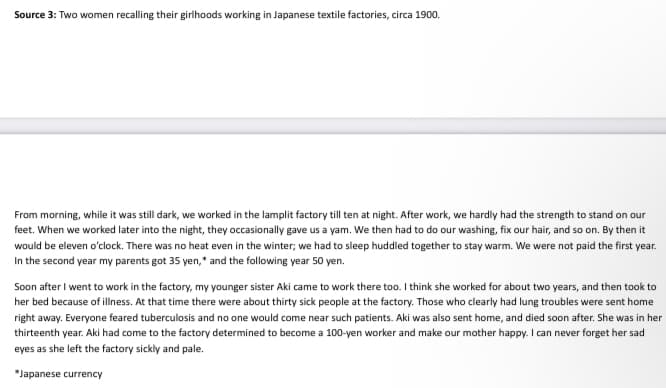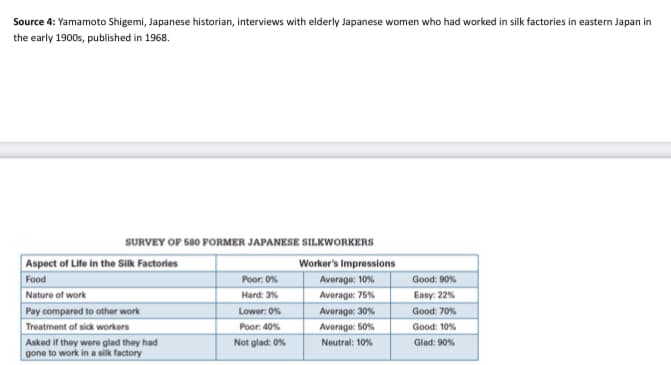Source 3: Two women recalling their girlhoods working in Japanese textile factories, circa 1900. From morning, while it was still dark, we worked in the lamplit factory till ten at night. After work, we hardly had the strength to stand on our feet. When we worked later into the night, they occasionally gave us a yam. We then had to do our washing, fix our hair, and so on. By then it would be eleven o'clock. There was no heat even in the winter; we had to sleep huddled together to stay warm. We were not paid the first year. In the second year my parents got 35 yen,* and the following year 50 yen. Soon after I went to work in the factory, my younger sister Aki came to work there too. I think she worked for about two years, and then took to her bed because of illness. At that time there were about thirty sick people at the factory. Those who clearly had lung troubles were sent home right away. Everyone feared tuberculosis and no one would come near such patients. Aki was also sent home, and died soon after. She was in her thirteenth year. Aki had come to the factory determined to become a 100-yen worker and make our mother happy. I can never forget her sad eyes as she left the factory sickly and pale. *Japanese currency Source 4: Yamamoto Shigemi, Japanese historian, interviews with elderly Japanese women who had worked in silk factories in eastern Japan in the early 19005, published in 1968. SURVEY OF 580 FORMER JAPANESE SILKWORKERS Aspect of Life in the Silk Factories Worker's Impressions Food Poor: 0% Average: 10% Good: 90% Nature of work Hard: 3% Average: 75% Easy: 22% Pay compared to other work Lower: 0% Average: 30% Good: 70% Treatment of sick workers Poor: 40% Average: 50% Good: 10% Asked if they were glad they had gone to work in a silk factory Not glad: 0% Neutral: 10% Glad: 90%
Source 3: Two women recalling their girlhoods working in Japanese textile factories, circa 1900. From morning, while it was still dark, we worked in the lamplit factory till ten at night. After work, we hardly had the strength to stand on our feet. When we worked later into the night, they occasionally gave us a yam. We then had to do our washing, fix our hair, and so on. By then it would be eleven o'clock. There was no heat even in the winter; we had to sleep huddled together to stay warm. We were not paid the first year. In the second year my parents got 35 yen,* and the following year 50 yen. Soon after I went to work in the factory, my younger sister Aki came to work there too. I think she worked for about two years, and then took to her bed because of illness. At that time there were about thirty sick people at the factory. Those who clearly had lung troubles were sent home right away. Everyone feared tuberculosis and no one would come near such patients. Aki was also sent home, and died soon after. She was in her thirteenth year. Aki had come to the factory determined to become a 100-yen worker and make our mother happy. I can never forget her sad eyes as she left the factory sickly and pale. *Japanese currency Source 4: Yamamoto Shigemi, Japanese historian, interviews with elderly Japanese women who had worked in silk factories in eastern Japan in the early 19005, published in 1968. SURVEY OF 580 FORMER JAPANESE SILKWORKERS Aspect of Life in the Silk Factories Worker's Impressions Food Poor: 0% Average: 10% Good: 90% Nature of work Hard: 3% Average: 75% Easy: 22% Pay compared to other work Lower: 0% Average: 30% Good: 70% Treatment of sick workers Poor: 40% Average: 50% Good: 10% Asked if they were glad they had gone to work in a silk factory Not glad: 0% Neutral: 10% Glad: 90%
Related questions
Question
Based on source 3, what are the Characteristics on Industrialization in Japan or Russia?
Based on source 4, what are the Characteristics on Industrialization in Japan or Russia?

Transcribed Image Text:Source 3: Two women recalling their girlhoods working in Japanese textile factories, circa 1900.
From morning, while it was still dark, we worked in the lamplit factory till ten at night. After work, we hardly had the strength to stand on our
feet. When we worked later into the night, they occasionally gave us a yam. We then had to do our washing, fix our hair, and so on. By then it
would be eleven o'clock. There was no heat even in the winter; we had to sleep huddled together to stay warm. We were not paid the first year.
In the second year my parents got 35 yen,* and the following year 50 yen.
Soon after I went to work in the factory, my younger sister Aki came to work there too. I think she worked for about two years, and then took to
her bed because of illness. At that time there were about thirty sick people at the factory. Those who clearly had lung troubles were sent home
right away. Everyone feared tuberculosis and no one would come near such patients. Aki was also sent home, and died soon after. She was in her
thirteenth year. Aki had come to the factory determined to become a 100-yen worker and make our mother happy. I can never forget her sad
eyes as she left the factory sickly and pale.
*Japanese currency

Transcribed Image Text:Source 4: Yamamoto Shigemi, Japanese historian, interviews with elderly Japanese women who had worked in silk factories in eastern Japan in
the early 19005, published in 1968.
SURVEY OF 580 FORMER JAPANESE SILKWORKERS
Aspect of Life in the Silk Factories
Worker's Impressions
Food
Poor: 0%
Average: 10%
Good: 90%
Nature of work
Hard: 3%
Average: 75%
Easy: 22%
Pay compared to other work
Lower: 0%
Average: 30%
Good: 70%
Treatment of sick workers
Poor: 40%
Average: 50%
Good: 10%
Asked if they were glad they had
gone to work in a silk factory
Not glad: 0%
Neutral: 10%
Glad: 90%
Expert Solution
This question has been solved!
Explore an expertly crafted, step-by-step solution for a thorough understanding of key concepts.
This is a popular solution!
Trending now
This is a popular solution!
Step by step
Solved in 2 steps
